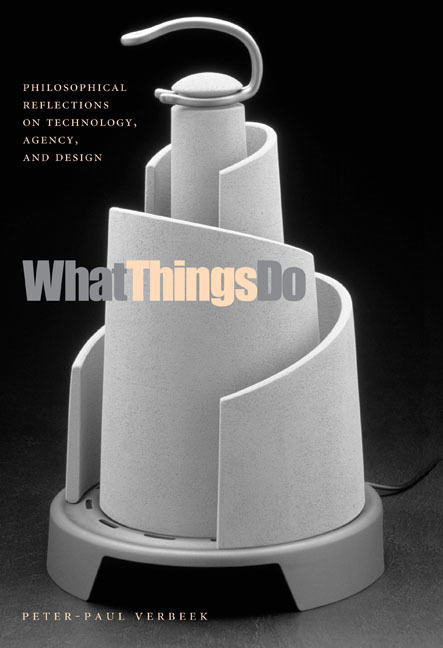Verbeek’s theory of technological mediation

Share this step
Expanding the mediation theory
Recent technological developments urge us to expand the range of human-technology relations that have been analysed in Ihde’s work. Verbeek has argued that postphenomenology should also be able to account for technologies like brain implants, domotics, and augmented reality devices, relations in which technologies start to merge either with the human body or with the environment (Verbeek 2008a). The spectrum of four human-technology relations identified by Ihde is primarily relevant for analysing human-technology configurations in which technologies are used. But at the extremes of this spectrum, other configurations become visible.
New ‘intentional relations’
In the spectrum from embodiment via hermeneutic and alterity to background relations, technologies move ever ‘further away’ from the human being as it were: from being an extension of the body via a ‘readable’ artefact and an object for interaction to the background of our experience. More intimate than a relation of embodiment, though, there is a relation of ‘fusion’, in which the physical boundaries between humans and technologies are blurred, and technologies merge with our bodies. And more radically ‘environmental’ or ‘ambient’ than the background relation, there is a relation of ‘immersion’, in which a technological background interacts actively with human beings. Moreover, augmented reality technologies, which add an extra layer to our experience of the world, open up a relation of ‘augmentation’.
In all of these new human-technology relations, new ‘intentional relations’ between humans and the world come into being. The concept of intentionality plays a central role in the phenomenological tradition, as part of its relational approach, to conceptualise the relation between human beings and their world. Human experience has an intentional structure: human beings are always directed toward reality. We cannot simply “see,” but we always see something; we cannot simply “hear” but always hear something; et cetera. We cannot understand human experience without taking into account this intentional directedness towards the world. In all of the human-technology-world relations Don Ihde analyses, technologies mediate this intentionality. In the new human-technology relations identified above, the technologically mediated character of intentionality takes on a different shape.
Explaining the ‘fusion’ relation
In the ‘fusion’ relation, technologies merge with our physical body. Good examples are neuro-implants for deep brain stimulation; cochlear implants that enable deaf people to hear again, or artificial heart valves and pacemakers. In all of these cases, the relations between humans and technologies are more intimate than in the embodiment relation. They involve much more than wearing a pair of glasses, or listening through a cell phone. Lucie Dalibert even speaks of ‘somatechnologies’: technologies that blur the boundaries between body and artefact (Dalibert 2014). This cyborg relation can be schematised as:
(I / Technology) –> World
Explaining the ‘immersion’ relation
I <-> Technology/World
Explaining the ‘augmentation’ relation
(I – Technology) –> World –> (Technology – World)
This formalism indicates that, such as with a pair of glasses I say “I see the world,” rather than “I, through my glasses, see the world.” While it also suggests that a technology is revealing a world to us we are incapable of seeing without it. The intentionality involved in such ‘augmentation relations’ can be indicated as ‘bifurcated’: there is a split in people’s directedness at the world, because two parallel fields of attention emerge.
Implications
From all of these relations, technologies help to shape human experiences and practices. Rather than being external to human beings, they help to shape what it means to be human. Technologies help to shape our knowledge of the world, our moral actions and decisions, and even our metaphysical and religious frameworks: MRI scanners provide neuroscientists a highly specific way to access the brain, while obstetric sonography informs ethical decisions about abortion, and IVF reorganises the boundary between the given and the made, or fate and responsibility. Technological mediation is part of the human condition – we cannot be human without technologies.
This makes the design of technologies a highly responsible activity. Designing technology is designing humanity, in a sense. Any technology will help to shape human actions and experiences, and will therefore have an impact that can be understood in ethical terms. Designers materialise morality (cf. Verbeek 2011). Beside functionality, interaction, and aesthetics, therefore, mediation deserved a central place in the conceptual framework that implicitly and explicitly guides design activities.
References
Dalibert, Lucie. Posthumanism and somatechnologies: exploring the intimate relations between humans and technologies. No. 14-303. Universiteit Twente, 2014.
Verbeek, Peter-Paul. “Morality in design: Design ethics and the morality of technological artifacts.” Philosophy and design. Springer Netherlands, 2008. 91-103.
Verbeek, Peter-Paul. Moralizing technology: Understanding and designing the morality of things. University of Chicago Press, 2011.
Further readings:
Verbeek, Peter-Paul. COVER STORY: Beyond interaction: a short introduction to mediation theory. interactions 22, 3 (April 2015), 26-31. DOI=http://dx.doi.org/10.1145/2751314
Share this
Philosophy of Technology and Design: Shaping the Relations Between Humans and Technologies

Philosophy of Technology and Design: Shaping the Relations Between Humans and Technologies


Reach your personal and professional goals
Unlock access to hundreds of expert online courses and degrees from top universities and educators to gain accredited qualifications and professional CV-building certificates.
Join over 18 million learners to launch, switch or build upon your career, all at your own pace, across a wide range of topic areas.
Register to receive updates
-
Create an account to receive our newsletter, course recommendations and promotions.
Register for free







